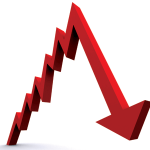 Yesterday, Wednesday, April 3, the Dow Jones and S&P 500 fell around a percent each, leaving a number of market participants to ask if the seasonal downturn was beginning.
Yesterday, Wednesday, April 3, the Dow Jones and S&P 500 fell around a percent each, leaving a number of market participants to ask if the seasonal downturn was beginning.
The “seasonal downturn”, as it is called, is what we’ve seen in the past few years: a sudden drop in stocks that hits around Q2 or Q3; in 2010, 2011, and 2012, we saw dips in April, July, and May, respectively. Now, investors are waiting for this seasonal dip to hit markets in 2013.
While recent history seems to suggest a seasonal dip in stocks is inevitable, this is not a historical trend of any length. Similar dips did not happen in the 1980s and 1990s, and the dot-com and housing bubbles of the 2000s showed other patterns altogether. This new pattern–a cycle of optimism, frustration, crash, and slow recovery–has become the dominant macroeconomic model amongst institutional and amateur investors.
For instance, look at the leader of this Bloomberg article: “Service industries expanded in March at the slowest pace in seven months and companies added fewer workers than forecast, indicating the U.S. economy is starting to cool.” This monthly dip of service-related activity comes from the Institute of Supply Management, which saw its non-manufacturing index fall to 54.4. That is a 2.8% fall from the previous number of 56, which was a one-year high.
Seasonality is built into weak March numbers–a period when it is still too cold in many places for shoppers to spend more, and there are no major events or holidays to boost shopping. While Easter may have gotten some people to buy Peeps and eggs, there’s little demand for services in March, which makes for lower seasonal aggregate demand.
Seasonality is supposedly baked in to yearly comps–when analyzing revenue and earnings growth, most investors look at year-over-year comparisons to avoid getting caught up in these seasonal variations.
But more recently, the horror of 2008 and 2009 has created a new type of macroeconomic scrutiny: an obsession on seasonal, quarter-over-quarter and month-over-month comps in an attempt to see any sign of a strong, resurgent economy. Instead of that, we are getting a slow and steady recovery that history will probably recognize as America’s lost decade.
Stocks, as a result, are losing buoyancy as that hope in early 2013 begins to slip away. The question going forward is whether that hope will come back, or if doubt will cause another seasonal dip.
It is hard to tell if other indicators are suggesting a seasonal crash resulting from dashed hope. U.S. consumer confidence has risen slightly, but weekly jobless claims rose by 28,000 at the end of March–contrary to analyst expectations of a slight drop in claims. Meanwhile, payroll firm ADP reported that 158,000 private sector jobs were added in March–below forecasts of 200,000. Still, stocks rose modestly throughout most of Thursday.
